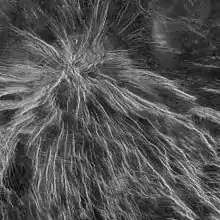Astrum
Astrum (lateinisch „Stern“, Plural Astra) oder Nova (lateinisch „neu“, Plural Novae) wird in der Astrogeologie gemäß der planetaren Nomenklatur ein Typus radialsymmetrischer morphologischer Strukturen auf der Venus genannt. Die Astra zeigen typischerweise ein dichtes Netz von einem Zentrum ausgehender Brüche. Ob alle Astra auf die gleiche Weise entstanden sind und wodurch sie entstanden sind, ist noch unklar. Die Astra sind auf der Oberfläche der Venus nicht zufällig verteilt, sondern zeigen Häufungen.[3]

Etwa 250 km breite Nova um den Gipfel von Ts'an Nu Mons, nordwestlich des Hochlands Themis Regio.
27,2° Süd, 272,9° Ost[1][2]
27,2° Süd, 272,9° Ost[1][2]
Als Teil einer offiziellen Bezeichnung sind Astrum und Astra von der IAU anerkannt.[4]
Siehe auch
Literatur
- A.T. Basilevsky, Jouko Raitala: Morphology of selected novae (astra) from the analysis of Magellan images at Venus. In: Planetary and Space Science Bd. 50, Heft 1 (Jan. 2002), S. 21–39
- H. Sigurdsson et al. (Hg.): Encyclopedia of Volcanoes. Academic Press, New York, S. 727
Einzelnachweise
- Venus quadrangle V-53 (mit Ts'an Nu Mons) im Gazetteer of Planetary Nomenclature der IAU (WGPSN)/USGS (PDF)
- Nova. springerreference.com
- M. Aittola, J. Raitala: Classifications of Venusian Novae (astra). In: European Planetary Science Congress 2006. Berlin, Germany, 18 - 22 September 2006. S. 313
- Descriptor Terms im Gazetteer of Planetary Nomenclature der IAU
This article is issued from Wikipedia. The text is licensed under Creative Commons - Attribution - Sharealike. The authors of the article are listed here. Additional terms may apply for the media files, click on images to show image meta data.